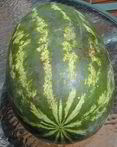Watermelon: Citrullus lanatus

Sugar Bowl Hybrid: The sweetest, best-tasting watermelon you could ever grow. 20-25 lbs. melons are distinctively striped on the outside and distinctively bright red, juicy and delicious on the inside.
Germinates: 7-14 days Harvest: 82 days Grown in: Full Sun
Nutrition Facts: Germination: How to Pick Fresh Watermelon:
Watermelon refers to both the edible fruit and vine-like plant (Citrullus lanatus of the family Cucurbitaceae) of a climbing and trailing herb originally from southern Africa and one of the most common types of melon. This flowering plant produces a special type of fruit known by botanists as a pepo, a type of egigynous berry or false berry (accessory fruit) that is derived from an inferior ovary. The watermelon has a thick rind (exocarp) and fleshy center composed of mesocarp and endocarp. The watermelon fruit, loosely considered a type of melon (although not in the genus Cucumis), has a smooth exterior green and yellow rind and a juicy, sweet, usually red or yellow, but sometimes orange, interior flesh. The plants produce male and female flowers separately on the same plant, and the female flowers have inferior ovaries. The flesh consists of highly developed placental tissue within the fruit.
All parts of the watermelon fruit are used by people, including the fleshy interior, the seeds, and the rind. The flesh may be eaten fresh or used to flavor drinks, and is an excellent source of vitamins C and A, as well as a good source of vitamin B6 and vitamin B1 and various minerals. The seeds are eaten as a snack or added to other dishes, and may be roasted and seasoned. They are a good source of fat and protein. The rind is edible and may be stir-fried, stewed, pickled or even grilled. Beyond these values, the watermelon plant provides aesthetic delight and the fruit an appeal to the senses of taste, sight, and touch. Ecologically, the watermelon flowers provide a source of nectar and pollen for bees.
It is believed to have originated in Africa. There, the ancestral melon grows wild and is known as the Tsamma melon (Citrullus lanatus var citroides). It is recognizable by its pinnatifid leaves and prolific fruit, up to 100 melons on a single vine. For this reason it is a popular source of water in the diet of the indigenous people. The flesh is similar to the rind of a watermelon and is often known as citron melon (distinct from the actual citron, of the citrus family). It is used for making pickles, and because of its high content of pectin is popular as a constituent of jams, jellies, and other gelled preserves. It has established itself in the wild in Baja California. All watermelons are 92% water and 6% sugar, which makes them very sweet.
Germinates: 7-14 days Harvest: 82 days Grown in: Full Sun
Nutrition Facts: Germination: How to Pick Fresh Watermelon:
Watermelon refers to both the edible fruit and vine-like plant (Citrullus lanatus of the family Cucurbitaceae) of a climbing and trailing herb originally from southern Africa and one of the most common types of melon. This flowering plant produces a special type of fruit known by botanists as a pepo, a type of egigynous berry or false berry (accessory fruit) that is derived from an inferior ovary. The watermelon has a thick rind (exocarp) and fleshy center composed of mesocarp and endocarp. The watermelon fruit, loosely considered a type of melon (although not in the genus Cucumis), has a smooth exterior green and yellow rind and a juicy, sweet, usually red or yellow, but sometimes orange, interior flesh. The plants produce male and female flowers separately on the same plant, and the female flowers have inferior ovaries. The flesh consists of highly developed placental tissue within the fruit.
All parts of the watermelon fruit are used by people, including the fleshy interior, the seeds, and the rind. The flesh may be eaten fresh or used to flavor drinks, and is an excellent source of vitamins C and A, as well as a good source of vitamin B6 and vitamin B1 and various minerals. The seeds are eaten as a snack or added to other dishes, and may be roasted and seasoned. They are a good source of fat and protein. The rind is edible and may be stir-fried, stewed, pickled or even grilled. Beyond these values, the watermelon plant provides aesthetic delight and the fruit an appeal to the senses of taste, sight, and touch. Ecologically, the watermelon flowers provide a source of nectar and pollen for bees.
It is believed to have originated in Africa. There, the ancestral melon grows wild and is known as the Tsamma melon (Citrullus lanatus var citroides). It is recognizable by its pinnatifid leaves and prolific fruit, up to 100 melons on a single vine. For this reason it is a popular source of water in the diet of the indigenous people. The flesh is similar to the rind of a watermelon and is often known as citron melon (distinct from the actual citron, of the citrus family). It is used for making pickles, and because of its high content of pectin is popular as a constituent of jams, jellies, and other gelled preserves. It has established itself in the wild in Baja California. All watermelons are 92% water and 6% sugar, which makes them very sweet.
